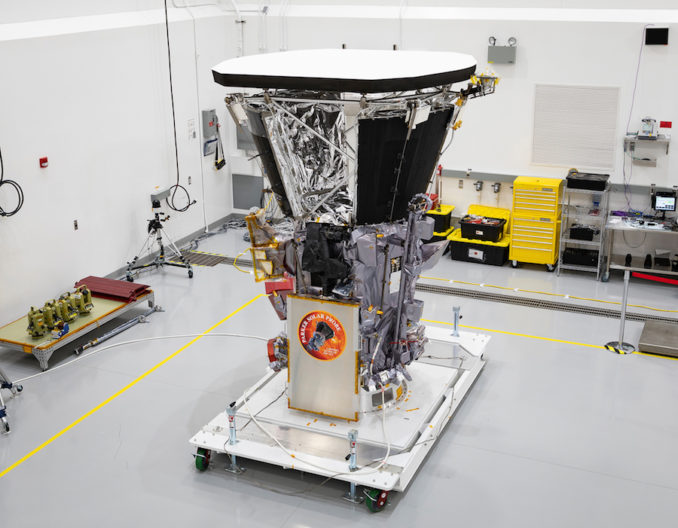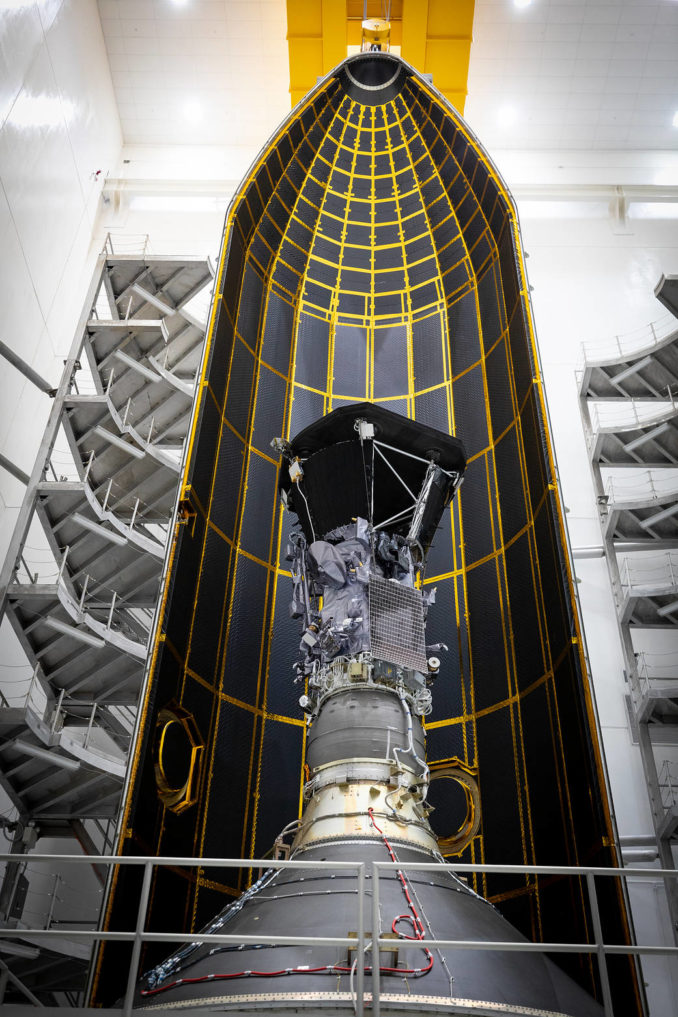Riding a slow-moving over-the-road transporter, the spacecraft, its solid-fueled Star 48BV upper stage, and protective aerodynamic fairing departed the Astrotech spacecraft processing facility in Titusville, Florida, late Monday for an overnight journey to the Complex 37B launch pad at nearby Cape Canaveral Air Force Station.
The convoy arrived at the launch pad before dawn Tuesday, and a heavy-lifting crane hooked to the 63-foot-tall (19-meter) fairing to hoist it atop a Delta 4-Heavy rocket, capping assembly of the launcher ahead of a predawn blastoff scheduled for Aug. 11.
The 45-minute launch window Aug. 11 opens at 3:48 a.m. EDT (0748 GMT), kicking off a 43-minute flight across the Atlantic Ocean before deployment of the 1,424-pound (646-kilogram) Parker Solar Probe spacecraft from the Star 48BV upper stage.
“I’m very happy to say that Solar Probe is in the fairing and … is on top of the Delta 4-Heavy,” said Nicky Fox, Parker Solar Probe’s project scientist at the Johns Hopkins University Applied Physics Laboratory, which developed the mission for NASA. “It was hoisted up this morning … I think it’s fair to say that Parker Solar Probe is go for the sun.”
Named for Eugene Parker, who correctly predicted the existence of the solar wind in 1958, Parker Solar Probe will head for Venus after its Aug. 11 launch, using the planet’s gravity to slingshot into a tighter orbit around the sun. Assuming launch occurs Aug. 11, Parker Solar Probe will reach Venus on Oct. 2, then make its first close approach to the sun — or perihelion — on Nov. 5.
During its first solar encounter later this year, Parker Solar Probe will reach a distance of roughly 15 million miles (24.1 million kilometers) from the sun’s surface, breaking a record set by the U.S.-German Helios 2 mission, which passed as close as 27 million miles (43.4 million kilometers) from the sun in April 1976.

Artist’s concept of Parker Solar Probe. Credit: JHUAPL
Six more Venus flybys will spiral Parker Solar Probe ever-closer to the sun, redirecting the craft’s trajectory toward its closest encounter with the sun at a distance of 3.83 million miles (6.16 million kilometers) in 2024, roughly 4 percent the distance of the sun from Earth.
“Venus is very important to us,” Fox said. “We actually use Venus to do gravity assists. Not like other missions you’ve heard about that take energy from the planet to speed up, we actually generously give energy to Venus, and we use Venus to slow us down just a little bit, really to focus our orbit, almost like doing a little handbrake turn and focusing us in towards the sun. We will do 24 petal orbits, coming very close to the sun on one side, going out around the orbit of Venus on the other.”
Parker Solar Probe will fly through the corona, a super-heated envelope of plasma surrounding the sun where temperatures soar to millions of degrees. The temperature at the surface of the sun is hundreds of times cooler, but still a blistering 10,000 degrees Fahrenheit (6,000 degrees Celsius).
The corona is also thought by scientists to be the origin of the solar wind, a supersonic stream of charged particles flowing away from the sun in every direction, influencing the entire solar system and driving space weather.
“How is the solar wind accelerated up to millions of mph very quickly in the solar corona? The work that Dr. Parker has laid out is the foundational work for understanding this process, and this is one of the primary goals of the Parker Solar Probe,” said Alex Young, associate director for science in the heliophysics division at NASA’s Goddard Space Flight Center in Maryland.
“Why does this all matter? We’re living in this dynamic sun’s atmosphere. We’re living in the solar wind streaming by the Earth, streaming by other planets,” Young said. “We see the beautiful results with the aurora, but this also creates an incredibly dynamic environment that impacts our technology, makes the environment hostile for astronauts, and in the most extreme cases, can even impact technology and power grids here on Earth.”
Parker Solar Probe’s arrival at the launch pad is a key milestone in the $1.5 billion mission’s launch campaign. In the coming days, ground crews will ensure the spacecraft is correctly attached to the Delta 4-Heavy rocket. Launch rehearsals are also on tap over the next week-and-a-half, according to Andrew Driesman, Parker Solar Probe’s project manager at the Johns Hopkins University Applied Physics Laboratory.
“Picture this 63-foot-high fairing on this vehicle moving through the Cape and part of Titusville,” Driesman said in an interview. “They arrive at the pad, hook it up to the crane, and lift this nearly 70-foot structure up to the top of the rocket, move it onto the top of the rocket, and then they bolt it on.
“Once we get there, after the mechanical operations are done, one of the first things we’ll do is power up the spacecraft and do what we call an aliveness test,” Driesman said. “That’s to make sure everything was transported safely, and there are no issues with either the spacecraft or the instruments.”

Parker Solar Probe on the move late Monday. Credit: Ken Kremer / kenkremer.com / spaceupclose.com
Launch was originally scheduled for July 31, but software reviews and snags encountered during encapsulation of the spacecraft inside the Delta 4-Heavy’s payload fairing forced a delay.
The mission’s launch period in August is governed by the positions of Earth and Venus in their orbits around the sun. Parker Solar Probe’s interplanetary launch period was supposed to close Aug. 19, but trajectory analyses suggest the mission could depart Earth through Aug. 23 and still meet its date with Venus in early October, giving managers an extra four launch opportunities after giving up the first 11 days of the interplanetary launch period.
If further delays keep Parker Solar Probe on Earth after Aug. 23, the next chance to launch the mission will come in May 2019.
But Driesman told Spaceflight Now he is confident the mission will get off the ground in August.
“The operations are proceeding at what I would call a normal pace,” he said. “There’s always time built in for not getting things right. At this point, we’re on track for the 11th (of August) launch date.”
Parker Solar Probe’s launch campaign got into full swing in April, with the arrival of the spacecraft at the Florida launch base from the Johns Hopkins University Applied Physics Laboratory on April 3. The probe’s heat shield arrived a couple of weeks later, and ULA crews transferred the Delta 4-Heavy rocket to the launch pad April 16, followed the next day by the raising of the launcher vertical.
Inside the clean room at Astrotech, technicians installed Parker Solar Probe’s power-generating solar arrays and heat shield over the past few months. The solar arrays have a custom design to withstand the blistering heat and sunlight the power generators will see near the sun, using a unique water cooling system to stay within temperature tolerances.
Workers also bolted on Parker Solar Probe’s heat shield, a 4.5-inch thick (11.4-centimeter) piece of carbon composite that stretches around 8 feet (nearly 2.5 meters) wide. The heat shield, or thermal protection system, will take the brunt of the heat during the probe’s close-up encounters with the sun, keeping most of the spacecraft — except for the solar arrays and a few scientific sensors — a bit above room temperature.
The spacecraft carries autonomous control software to ensure temperature-sensitive components don’t get too hot, using inputs from temperature sensors to gauge where the probe should be pointed. Some of the sensors failed during testing, so engineers added a redundant set to the spacecraft, according to Fox.
Parker Solar Probe’s team at Astrotech loaded around 176 pounds (80 kilograms) of hydrazine into the craft’s monopropellant propulsion system July 7. The probe will use the fuel and 12 tiny rocket thrusters to tweak its trajectory over its seven-year-plus mission, and help unload momentum from four spinning reaction wheels located inside the spacecraft’s main body, which will control the orbiter’s pointing.

Parker Solar Probe inside the clean room at Astrotech. The white ceramic coating on the probe’s carbon heat shield is visible at the top of the spacecraft. Credit: NASA/JHUAPL/Ed Whitman
Once fueled, Parker Solar Probe was lifted on top of its Star 48BV rocket motor, which will act as a third stage during launch. Fitted with a vectoring nozzle, the solid-fueled kick stage was built by Northrop Grumman Innovation Systems, formerly known as Orbital ATK.
The Star 48BV motor will fire for approximately 89 seconds after separation from the Delta 4-Heavy’s second stage, giving Parker Solar Probe an extra velocity boost. The Delta 4-Heavy’s triple-core first stage, powered by three RS-68A main engines producing 2.1 million pounds of thrust, will give the mission its initial lift, followed by two firings of an RL10 upper stage engine before the Star 48BV burn.
“Since we’re going so close to the sun, we have to lose a lot of energy, a lot of angular momentum, associated with the Earth’s orbit,” said Jim Kinnison, Parker Solar Probe’s mission system engineer, in an interview with Spaceflight Now. “To do that, we need a really big rocket that can provide us with a high (escape velocity). The Delta 4-Heavy was the best we could get, but even that wasn’t sufficient. We still need a third stage to provide even more of a boost for us. The third stage will do that, but we’re also targeting Venus for gravity assists to lose even more.”
During its closest approaches in 2024 and 2025, Parker Solar Probe will experience 478 times the sunlight present at Earth, which orbits around 93 million miles (150 kilometers) from the sun. The spacecraft’s velocity will jump to roughly 430,000 mph — 120 miles per second or nearly 700,000 kilometers per hour — during its final perihelion passages, setting a new mark for the fastest human-made object in history.
SpaceX’s Falcon Heavy rocket can carry heavier cargo than the Delta 4-Heavy, but NASA would not commit to launching a high-priority science probe on an unproven booster. At the time of NASA’s selection of the Delta 4-Heavy rocket for the Parker Solar Probe mission in early 2015, the Falcon Heavy was still three years from its first test flight.

Parker Solar Probe and its Star 48BV kick stage are pictured inside one-half of the Delta 4-Heavy rocket’s payload shroud earlier this month at the Astrotech processing facility. Credit: NASA/JHUAPL/Ed Whitman
With the spacecraft now on its Delta 4-Heavy launcher, the ULA and Parker Solar Probe teams plan to conduct an integrated systems test, a checkout to verify proper electrical connections between the rocket and payload. Engineers also plan to condition Parker Solar Probe’s battery to maximize its lifetime, according to Driesman.
“We (will) go through basically a verification of all the flight software and parameters,” Driesman said. “We’ll dump every single bit off the spacecraft and compare it to what it should be, and make sure that we’ve got a good load of not only the flight software, but the parameters themselves.”
There are also practice runs for the launch team planned. ULA’s controllers already accomplished two countdown rehearsals in early July, during which they filled the Delta 4-Heavy with liquid hydrogen and liquid oxygen, then drained the cryogenic propellants from the rocket.
Technicians will also enter the Delta 4-Heavy’s payload shroud to take off “remove-before-flight” covers protecting sensitive scientific instrumentation.
“We do some further launch rehearsals to make sure the team is as ready as the spacecraft is,” Driesman said. “And then we’ll go into the fairing. There are just a few red tag covers on-board that cover some sensitive instruments. We’ll crawl into the fairing and remove the red tag covers, and then we’re pretty much, at that point, ready to launch.”
Read the original article on spaceflightnow.com.
More about: space
















































